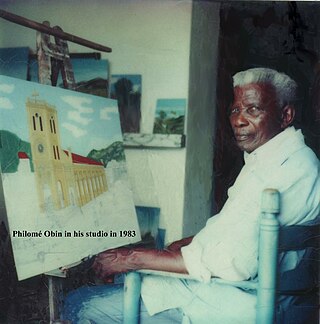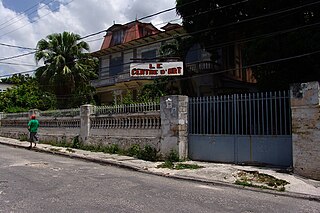
Port-au-Prince is the capital and most populous city of Haiti. The city's population was estimated at 1,200,000 in 2022 with the metropolitan area estimated at a population of 2,618,894. The metropolitan area is defined by the IHSI as including the communes of Port-au-Prince, Delmas, Cité Soleil, Tabarre, Carrefour, and Pétion-Ville.

Ouest or Lwès is one of the ten departments of Haiti. It is located in south-central Haiti, linking the Great-North and the Tiburon Peninsula.
Stevenson Magloire was a painter born in Pétion-Ville, Haiti. He is the son of artist Louisiane Saint Fleurant, a founder of the School of Soleil art movement. Magloire's paintings are bold and expressionistic, frequently incorporating people, birds, and Vodou and Christian symbolism.

Prospère Pierre-Louis (1947–1997), also known as Prosper Pierre-Louis, was a Haitian artist, painter and one of the main contributors to the Saint Soleil art movement. His paintings depicting mystical Vodou lwa and spirits are especially noteworthy.

Philomé Obin was a Haitian painter. He produced his first painting in 1908 at the age of 16, and was an active artist for 75 years. Obin is considered one of the greatest Haitian artists of the 20th century.
Jacques-Enguerrand Gourgue was one of Haiti's most renowned painters of the 20th century.
Ralph Allen is a Haitian painter. Born in Port-au-Prince, Allen was awarded a scholarship to the National Academy of Design's School of Fine Arts in New York City. His paintings have been exhibited at the Loeb Center at New York University, the National Audubon Society, and at his alma mater, the National Academy of Design.

Wilson Bigaud was a Haitian painter. Born in Port-au-Prince, Bigaud first worked with clay before becoming a painter.
Jean-Claude "Tiga" Garoute was a Haitian painter and sculptor. Born in Jérémie, Garoute co-founded a museum of ceramic art in Haiti named Poto-Mitan. An abstract painter, he participated in art festivals throughout the world.
Nehemy Jean (1931–2007) was a Haitian painter and graphic artist. Born in Limbé, Jean worked as a graphic artist and studied portraiture. He painted murals at the Port-au-Prince International Airport. His works have been exhibited in Europe and the United States. He joined the Centre d'Art in 1947 and was active in the founding of the Foyer des Arts Plastique. Jean died in 2007.
Murat Brierre or Murat Briere (1938–1988) was one of Haiti's principal metal sculptors and was known for his recycling of surplus oil drum lids. He was influenced by George Liautaud, but his work acquired its own highly experimental style, often focusing on multi-faceted and conjoined figures, fantastically personified elements, and unborn babies visible within larger creatures.

Damage to infrastructure in the 2010 Haiti earthquake was extensive and affected areas included Port-au-Prince, Petit-Goâve, Léogâne, Jacmel and other settlements in southwestern Haiti. In February Prime Minister Jean-Max Bellerive estimated that 250,000 residences and 30,000 commercial buildings had collapsed or were severely damaged. The deputy mayor of Léogâne, which was at the epicenter of the earthquake, reported that 90% percent of the buildings in that city had been destroyed and Léogâne had "to be totally rebuilt." Many notable landmark buildings were significantly damaged or destroyed, including the Presidential Palace, the National Assembly building, the Port-au-Prince Cathedral, and the main jail. The Ministry of Education estimated that half the nation's 15,000 primary schools and 1,500 secondary schools were severely damaged, cracked or destroyed. In addition, the three main universities in Port-au-Prince were also severely damaged. Other affected infrastructure included telephone networks, radio station, factories, and museums. Poor infrastructure before the earthquake only made the aftermath worse. It would take half a day to make a trip of a few miles. The roads would also crisscross haphazardly due to disorganized construction.

Louisiane Saint Fleurant was a Haitian female artist and painter. She was a founder of the peasant Saint Soleil art movement.
Laurent Casimir was a Haitian artist.

Andrée Malebranche was an Afro-Haitian painter and art instructor. She has works included in the collections of the Musée d'Art Haïtien and was recognized by the Haitian government for her contributions to the development of Haitian painting.
Claude Dambreville was a Haitian writer and painter. He won the annual literary Henri Deschamps award for his novel, Un gout de Fiel.

Le Centre d'Art, also known as Centre d'Art d'Haïti, is an art center, art school and art gallery located in Port-au-Prince, Haiti. It was founded in 1944 by American watercolorist DeWitt Peters and several prominent Haitians from the intellectual and cultural circles such as Maurice Borno, Albert Mangonès, Geo Remponeau, Jean Chenet and Gerald Bloncourt. In 2010, the center's building was destroyed; by 2012 they continued offering classes; and the center's new building was scheduled to reopen by 2021.
Galland Semerand was a Haitian painter and architect.
Salnave Philippe-Auguste was a Haitian painter, lawyer, and magistrate known for his jungle scenes.








